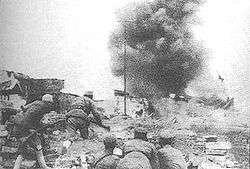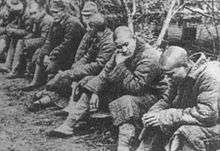Battle of Changde
| Battle of Changde | |||||||||
|---|---|---|---|---|---|---|---|---|---|
| Part of the Second Sino-Japanese War of World War II | |||||||||
 Chinese troops in combat at Changde | |||||||||
| |||||||||
| Belligerents | |||||||||
|
|
| ||||||||
| Commanders and leaders | |||||||||
|
|
| ||||||||
| Strength | |||||||||
| ~210,000 | 61,000 | ||||||||
| Casualties and losses | |||||||||
| 20,000 |
1,274 dead 2,977 wounded[3] | ||||||||
The Battle of Changde (Battle of Changteh; simplified Chinese: 常德会战; traditional Chinese: 常德會戰; pinyin: Chángdé Huìzhàn) was a major engagement in the Second Sino-Japanese War in and around the Chinese city of Changde (Changteh) in the province of Hunan. During the battle, the Imperial Japanese Army extensively used chemical weapons.
The purpose of the Japanese offensive was not to hold the city, but to maintain pressure on the Chinese National Revolutionary Army to reduce their combat ability in the region, and their ability to reinforce the Burma Campaign."[2]
The Japanese were initially successful in their offensive operation, capturing the city of Changde and causing terror among its civilians. However, they were pinned down in the city by a single Chinese division long enough for other Chinese units to surround them with a counter-encirclement. Heavy casualties and the loss of their supply lines then forced the Japanese to withdraw, returning territorial control to the original status quo.[1]
Some contemporary Western newspapers depicted the battle as a Chinese victory.[4][5][6][7][8] American government film footage showed victorious Chinese troops with Japanese prisoners and captured Japanese flags and equipment on display after the battle.[9] In addition, an American newsreel titled "Chinese troops drive Japs from Changteh" showed Chinese troops firing, with dead and captured Japanese on display.[10]
Battle
Japanese offensive
On 2 November 1943 Isamu Yokoyama, commander of the Imperial Japanese 11th Army, deployed the 39th, 58th, 13th, 3rd, 116th and 68th divisions—a total of around 60,000 troops—to attack Changde from the north and the east. The Changde region was defended by the Chinese 6th War Zone's 10th, 26th, 29th and 33rd Army Groups, as well as a river defense force and two other corps, for a total of 14 corps.[1]
On 14 November the Japanese 13th Division, with aid from collaborators, drove south and broke through the Chinese defensive lines placed by the 10th and the 29th Group Armies. On 16 November, the Japanese paratroopers landed in Taoyuan County to support the assault on the city proper. At the same time, the Japanese 3rd and 116th Divisions also joined the combined assault. The city was guarded by the Chinese 57th Division from the 74th Corps, whose commander, Yu Chengwan, led his single division of 8,000 men to fight against the two invading Japanese divisions. Despite of overwhelming numerical inferiority, the Chinese stubbornly held onto the city. Eleven days and nights of fierce fighting saw heavy casualties on both sides. When the Chinese reinforcements finally arrived in the city, they managed to evacuate the remaining 100 survivors in the 57th Division, all of whom were wounded, from the city. On 6 December the city of Changde fell to the Japanese control.[1]
While the Chinese 57th Division pinned down the Japanese in the city, the rest of the 74th Corps, as well as the 18th, 73rd, 79th and 100th Corps and the 9th War Zone's 10th Corps, 99th Corps and Jiangxi's 58th Corps, arrived at the battlefield, forming a counter-encirclement on the Japanese forces.[1]
Chinese counter-offensive
Fang Xianjue's 10th Corps was first to strike, successfully retaking Deshan on 29 November before attacking the Japanese positions at Changde from the south. Unable to withstand the fierce Chinese assault, the Japanese utilized chemical weapons.[11] The battle lasted for six days and nights, during which the Chinese 10th Division's commander, Lt. Gen. Sun Minjin, died from five bullet wounds.[1]
At this time other Chinese units were also pressing onto the Japanese positions. On 11 December Chinese reinforcements broke through the Japanese lines and into the city, which resulted in intense house-to-house fighting. The Chinese then proceeded to cut the Japanese supply lines. Depleted of food and ammunition, the Japanese retreated on 13 December.[1] The Chinese pursued them for more than 20 days. By 5 January 1944 Japanese forces had withdrawn to their original positions before the offensive.[1]
During this campaign, apart from the 10th Division's Sun Minjin, two other Chinese division commanders were killed. One was the 44th Corps' 150th Division's Lt. Gen. Xu Guozhang, the other was the 73rd Corps' 5th Division's Lt. Gen. Peng Shiliang. Xu, 37, was killed at Taifushan in Changde's northwest. Peng, 38, was killed at the Taoyuan-Shimen line.[1]
The Changde campaign had the largest participation of the Chinese air force since the Battle of Wuhan.[1]
Reporter Israel Epstein witnessed and reported on the battle. Witold Urbanowicz, a Polish fighter ace engaged in air combat over China in 1943, saw the city just after the battle. According to Urbanowicz, nearly 300,000 civilians died during the fighting in Changde.[2]

The 2010 Chinese war film Death and Glory in Changde is based on the events in this battle.
References
- 1 2 3 4 5 6 7 8 9 10 Documentary about the Battle of Changde – via You Tube.
- 1 2 3 ed. Hsiung, James C. and Steven I. Levine China's Bitter Victory: The War with Japan 1937–1945, p.161
- ↑ Japanese Monograph No. 71, "Army Operations in China" pp. 170
- ↑ Simon Newton Dexter North; Francis Graham Wickware; Albert Bushnell Hart (1944). The American Year Book: Volume 29. T. Nelson & Sons. p. 94. Retrieved 2010-06-28.
- ↑ George Creel (1949). Russia's race for Asia. Bobbs-Merrill Co. p. 214.
- ↑ Free world, Volume 8. Free World, Inc. 1944. p. 309.
- ↑ Philip J. Jaffe (1943). Amerasia, Volume 7. Amerasia, inc. Retrieved 2010-06-28.
- ↑ Inc, Time (21 February 1944). "LIFE". Time Inc. Retrieved 5 June 2016 – via Google Books.
- ↑ "HD Stock Video Footage – Chinese troops defeat the Japanese in Changde China and capture their military equipment during World War II". Retrieved 5 June 2016.
- ↑ "HD Stock Video Footage – Newsreel 'Chinese troops drive Japs from Changteh'". Retrieved 5 June 2016.
- ↑ Agar, Jon Science in the 20th Century and Beyond, p.281
Sources
- Hsu Long-hsuen and Chang Ming-kai, History of The Sino-Japanese War (1937–1945) 2nd Ed., 1971. Translated by Wen Ha-hsiung, Chung Wu Publishing; 33, 140th Lane, Tung-hwa Street, Taipei, Taiwan Republic of China. Pg. 412–416 Map 38
- Daniel Barenblatt, A plague upon Humanity, HarperCollins, 2004, pp. 220–221
External links
| Wikimedia Commons has media related to Battle of Changde. |
- Axis History Forum Index; WW2 in the Pacific & Asia; Battle of Changde Order of Battle and Map, Photos from Changde (常德) War Memorial
- RESISTANCE WARS; Campaign of E-Xi, Battle Of Changde
- Captured Japanese soldier
Coordinates: 29°02′00″N 111°40′59″E / 29.0333°N 111.6830°E